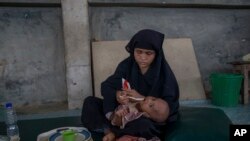The U.N. children’s fund warns potentially life-threatening malnutrition is soaring among Rohingya refugee children who have fled to Cox’s Bazar, Bangladesh to escape violence and abuse in Myanmar.
The U.N. children’s fund does not know the extent of acute malnutrition among Rohingya child refugees. So, UNICEF spokeswoman Marixie Mercado says a nutrition survey is underway that will provide vital data when it is completed in November.
“What we already know is that the combination of malnutrition, sanitary conditions, and disease in the refugee settlements, is potentially catastrophic for children," said Mercado.
More than 600,000 Rohingya refugees have arrived in Cox’s Bazar since August 25 to escape violence and persecution in Myanmar’s Northern Rakhine State. Children comprise nearly 60 percent of the refugees.
Mercado says UNICEF screened several hundred children who were stuck at the border during the mass influx in mid-October. She says dozens of children were found to be severely acutely malnourished and in need of immediate life-saving treatment.
She says screening conducted by Doctors Without Borders found 14 cases of the worst form of malnutrition among 103 children.
“This is an extremely small number of children, so these numbers are not representative," said Mercado. "But, what they do tell us is that at least some of the children are close to death by the time they make it across the border.”
UNICEF spokeswoman Mercado says the spread of infectious diseases is also of concern. She notes measles cases have been reported among newly arrived children as well as those who have been living in Cox’s Bazar for some time.
She says the risk of diarrheal disease and dysentery is exceptionally high in the overcrowded, unsanitary conditions in which the children live.










